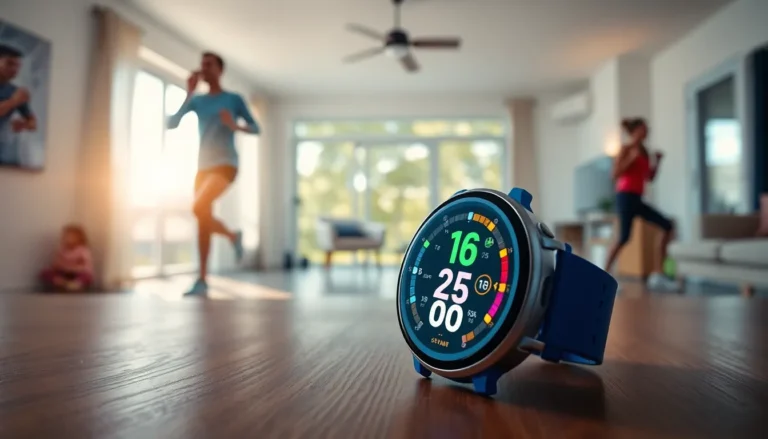In a world where everything seems to be one hack away from chaos, security-focused wearables are stepping up as the unsung heroes of personal protection. These nifty gadgets don’t just track your steps or monitor your heart rate; they’re like having a personal bodyguard right on your wrist. Imagine a device that not only keeps your data safe but also makes you look stylish while doing it. Who knew security could be so fashionable?
From smartwatches that alert you to suspicious activity to fitness bands that keep your health data encrypted, wearables are redefining how we think about safety. It’s time to trade in that old-fashioned sense of security for a sleek, tech-savvy solution. Dive into the world of security-focused wearables and discover how they can transform your daily life from mundane to secure, all while adding a touch of flair.
Table of Contents
ToggleOverview of Security-Focused Wearables
Security-focused wearables have become essential tools for personal safety. Many devices include features such as GPS tracking, which enables users to share their location with trusted contacts. Alerts for suspicious activity serve as an important precaution, notifying wearers of potential threats in real time.
Health data encryption ensures sensitive information remains protected against unauthorized access. These devices offer a variety of applications, allowing users to monitor their well-being while safeguarding their privacy. Wearables also incorporate emergency response options. Pressing a button can send alerts to emergency services or designated friends.
Device aesthetics play a significant role in user adoption. Many security-focused wearables blend seamlessly into everyday outfits, appealing to style-conscious individuals. Manufacturers emphasize both security functions and design to create attractive options for consumers.
Integration with smartphone apps enhances user experience. Companion apps allow for personalized settings and notifications based on individual preferences. Moreover, updates to software ensure that devices remain secure against new threats.
Data on user demographics indicates a growing market for security wearables. Surveys show increased interest among young adults, who prioritize safety features in their tech purchases. As awareness of personal safety continues to rise, the popularity of these gadgets is likely to expand.
Overall, security-focused wearables provide valuable protection while seamlessly fitting into modern lifestyles. With advancements in technology, these devices are likely to become even smarter and more adaptive to individual user needs.
Types of Security-Focused Wearables

Security-focused wearables comprise diverse devices tailored to enhance personal safety. Each type integrates unique features promoting user protection in various situations.
Smartwatches
Smartwatches designed for security offer functionalities such as SOS alerts and GPS tracking. Some models include health monitoring tools that safeguard user information through encryption. Notifications about unusual activity can promptly reach the user. Many smartwatches also connect to emergency services, ensuring swift responses. The combination of style and safety makes these wearables attractive to tech-savvy individuals.
Fitness Trackers
Fitness trackers prioritize health and security with features like heart rate monitoring and fall detection. Certain models send alerts to emergency contacts when a fall occurs. Users appreciate data protection as much as fitness statistics. Wearables in this category often sync with mobile applications, allowing for tailor-made security settings. Emphasizing personal safety elevates their value in today’s health-conscious market.
Home Security Devices
Home security devices extend protection beyond personal wearables, integrating with the user’s environment. Smart doorbells, cameras, and security systems help monitor surroundings and recognize intruders. These devices often include smartphone connectivity for real-time alerts. Remote monitoring capabilities enhance convenience, allowing users to oversee their properties from anywhere. Shoppers increasingly seek these integrated solutions, blending functionality with security for greater peace of mind.
Key Features of Security-Focused Wearables
Security-focused wearables provide advanced features that significantly enhance user safety. These functionalities include data encryption, real-time monitoring, and customizable privacy settings.
Data Encryption
Data encryption secures sensitive information by converting it into an unreadable format. Users benefit from encrypted health data, protecting personal health metrics from unauthorized access. Devices employ advanced encryption protocols, ensuring that only intended recipients access shared information. Many wearables utilize end-to-end encryption, enhancing data security during transmission. As a result, users gain peace of mind knowing their private data remains confidential.
Real-Time Monitoring
Real-time monitoring enables wearables to track activity and health metrics continuously. These devices can alert users instantly in case of emergencies, such as sudden falls or health anomalies. GPS tracking allows for location sharing with trusted contacts, enhancing personal safety when needed. Some wearables support integration with emergency services, ensuring timely assistance. With these monitoring capabilities, users experience a greater sense of security in their daily lives.
User Privacy Settings
User privacy settings allow individuals to customize how their data is shared and stored. Many wearables offer options to control access to information, including shared health metrics and location data. Users can enable or disable specific features based on their comfort levels. This flexibility encourages users to prioritize their privacy while enjoying the benefits of tech advancements. Robust privacy controls ensure that security-focused wearables cater effectively to personal preferences.
Benefits of Using Security-Focused Wearables
Security-focused wearables offer numerous advantages that enhance personal safety and responsiveness in emergencies. These gadgets not only provide stylish solutions but also prioritize user protection in various situations.
Enhanced Personal Safety
Personal safety receives a significant boost from security-focused wearables. Users benefit from features like GPS tracking, which allows loved ones to monitor their location in real time. Additionally, smartwatches equipped with SOS alerts can instantly notify emergency services with a simple button press. Such wearables also often include health monitoring tools, like heart rate sensors, that prompt alerts during unusual physiological changes. Fall detection capabilities send notifications to emergency contacts, ensuring help reaches users promptly. Overall, these functionalities create a comprehensive safety net tailored to individual needs.
Quick Response to Threats
Quick response to potential threats is another critical advantage of security-focused wearables. Many devices provide immediate alerts for suspicious activity in the user’s vicinity. Integration with smartphone applications allows for customized notifications tailored to user preferences. When a risk is detected, users receive real-time updates, enabling them to take appropriate action. Enhanced connectivity with emergency services facilitates rapid communication during crises. Wearables encourage a proactive approach to personal security, allowing users to feel empowered and informed in threatening situations.
Challenges and Considerations
Security-focused wearables face several challenges that users must address. Privacy remains a significant concern, particularly as these devices collect sensitive personal data. Data breaches pose risks, as unauthorized access can lead to identity theft or misuse of health information. Users often seek assurance that their data remains secure and confidential.
Battery life also presents challenges. Many wearables rely on continuous monitoring and connectivity, leading to faster battery depletion. Users may find themselves recharging their devices frequently, which can diminish the convenience factor. Technology limitations may hinder functionality, as some wearables might not support advanced features due to hardware constraints. Regular updates and advancements aim to improve these devices, though issues with compatibility and longevity remain prevalent.
Security-focused wearables represent a significant advancement in personal safety technology. As these devices evolve they blend functionality with style to meet the needs of modern users. The ability to monitor health metrics and provide real-time alerts ensures that individuals can respond swiftly to potential threats.
While challenges like privacy concerns and battery life remain, ongoing innovations promise to enhance user experience and security. Embracing these wearables not only enhances personal safety but also empowers individuals to take control of their well-being in an increasingly complex world. As technology continues to advance these devices will likely become indispensable tools for personal protection.









